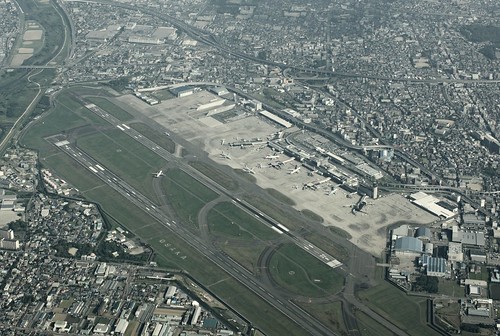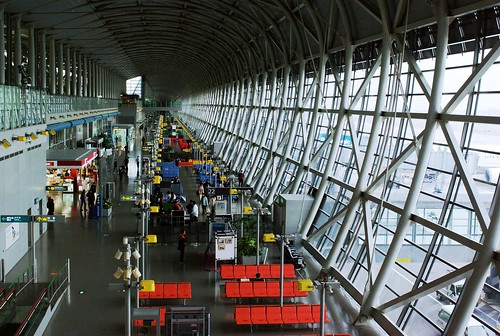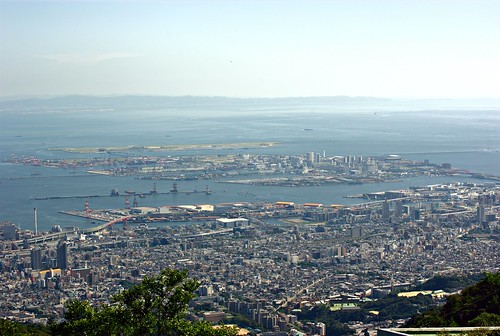Here in Kansai the problems are more chronic in nature. We have an airport congestion problem - not congestion of airplanes, mind you, but of airports. There's three main airports around here:
- Itami airport, also called Osaka International Airport, is an old, long-established airport, so construction is long-since paid off. And it's just north of Osaka city, right between Osaka and Kobe, close to both major highways and several train lines, so it's very convenient for a lot of people.
But that's the problem. When the airport was established some seventy years ago the area was still largely rural. Today the area is densely populated, and the airport is crammed in among apartment buildings, offices and factories. Most approaches to the airport pass right over some of the densest areas in the city1, so noise, pollution and safety concerns set hard limits on the number and type of aircraft that can use the airport. As a practical matter the airport could not expand to accommodate more air traffic anyhow since there's simply no more space available.
Kansai Airport departure hall. Spacious, well-designed airport (consistently highly ranked) with plenty of room to grow. Unfortunately, it's saddled with a very heavy debt load which drives up landing and concession fees.
- Kansai Airport opened some fifteen years ago to offload the straining Itami. It's on an artificial island in the Osaka bay, so noise, safety and local pollution is not a problem. It can accommodate more and larger aircraft than Itami, and the terminal and other buildings are modern and can handle large passenger inflows. And of course, would the need ever arise, it's always possible to expand the island with a third runway.
But, the site, well south of Osaka and the main population centers, is a little off for a lot of Kansai residents (I've heard the site was chosen in part as a precondition for southern cities pitching in for the construction). An off-shore site close to Itami around the Osaka-Hyogo border would perhaps have been better. And the construction was very expensive, so the airport is saddled with huge debts. In order to cover the debt payments the aircraft landing fees are very high, which discourages air companies from using the airport and increasing the ticket cost. As a result it has been underutilized even as Itami is full.
Kobe airport. Actually, it's Kobe, followed by Port Island; Kobe airport is the greenish strip of land at the back, right up against Seto inland sea.
- Kobe Airport is one of those ideas that probably seemed good at the time. The site was first considered for Kansai airport, but Kobe opposed the idea and Kansai airport ended up south of Osaka instead. After the Hanshin earthquake the idea of an off-shore airport was revived and approved and the airport opened a few years ago.
However, it is small, inconveniently located and usage projections where grossly optimistic. It is underutilized already, and JAL - in effective bankruptcy - is cutting all its routes to Kobe, leaving the airport with only half the current flights. It is, in short, one of those recently opened regional airports that were backed by inflated traffic projections and a distorted subsidy system, hobbled by a lack of demand and large loans and facing a very uncertain future2.
With uneven capacity use and a long economic slump, these three airports - and their respective political champions - have been fighting over the air travel business in the region, with all three losing out as a result. The discord has prevented the region from speaking with one voice on this on the national level. Negotiations with the central government on modifying the debt burden on Kansai airport has gone nowhere, for instance, since the region hasn't been able to present a coherent view on what it wants to see happen to the place. And backers of Tokyo's airport system wants to direct all long-range international travel through Haneda and Narita in Tokyo rather than Kansai Airport3; they've been able to push that vision in part because of the local discord in Kansai.
But last week, the Osaka and Hyogo governors among others held a regional conference to resolve the problem. They managed to produce a vague, tentative agreement on the future of Kansai air travel with lots of unanswered questions and unspecified details. This may sound bad, but it's a major step forward from the sharp disagreements that have hobbled the issue up until now.
The basic idea is to bring all three airports under the same management. Kansai airport would become the main hub for the area - not surprising of course as that's the only one with the required capacity. Itami will be focusing on business flights and small-aircraft aviation, which would relieve both noise and other environmental problems around the airport while still keeping it open as a general airport. Kobe would become a supporting airfield to Kansai - the airports are far away over land, but the ferry across takes less than half an hour, much closer than, say, Kansai and Itami or Haneda and Narita for that matter.
There's a lot of important unanswered questions here, beginning with the crippling debt level of Kansai airport, but for the first time the region is all on the same page on this issue. Up until now, the national government has been able to point at the internal divisions in Kansai as an excuse to avoid having to deal with it; at last that stumbling block seems to be removed. Now, of course, the question is to what degree there's a coherent national government to negotiate with any more, but that's a problem for another day.
--
#1 A night landing at Itami coming in from the south is spectacular. You pass over all of central and north Osaka at low altitude, with the sea of city lights streaming past just below, and the high-rises of Umeda passing by close enough you could almost touch them.
#1 It doesn't help, as last Thursday's newspaper pointed out, that airport management often is split, with the public stuck with the capital intensive, money losing core elements of these airports, while the lucrative parts such as parking management has been given away to private businesses in return for amakudari positions.
If the public - that is we, you and I - has to take responsibility for the money-losing side, we should get the rights for the profitable parts too. Nobody should be able to cherry-pick just the money-making bits; if a business wants a part of the airport business then they should be on the hook for their share of the expenses that enable that business in the first case.
If the public - that is we, you and I - has to take responsibility for the money-losing side, we should get the rights for the profitable parts too. Nobody should be able to cherry-pick just the money-making bits; if a business wants a part of the airport business then they should be on the hook for their share of the expenses that enable that business in the first case.
#3 I doubt that'd work though. If Haneda and Narita would become the only gateways for transcontinental flights, it'd be faster and more convenient to take the short hop to Incheon in South Korea and fly from there instead.
Besides, it doesn't sound very prudent to concentrate all international traffic into a single area where one good typhoon or snowstorm could disable every flight.
Besides, it doesn't sound very prudent to concentrate all international traffic into a single area where one good typhoon or snowstorm could disable every flight.




Good to hear they are making some progress in organising themselves.
ReplyDeleteThe number of Japanese airports is amazing. 98 in total I think it is now, with the latest new one opening recently not that far from Narita.
What was the point of that ? There are literally two (or three flights at most) a day from it! There's no rail station anywhere near it.
A serious 'pork barrel' project if ever there was one.
With JAL planning on pulling out of more domestic routes you would expect to see some airports actually close down... But I can't see it happening.
The problem is in part that some part of the revenue from the air transport sector - landing fees, fuel taxes and so on - has long gone to a fund for infrastructure projects. It's one of those ideas about keeping money within the transport sector (instead of being wasted on the sick and poor I guess). Of course, there's a fairness argument to it as well, about giving otherwise weak regions the resources to be a connected part of the country.
ReplyDeleteBut that fund has meant that building an airport is much cheaper for a municipality or region than it would otherwise be. And an airport isn't just a runway and a terminal, but a whole set of local infrastructure projects - new industrial zone, improved roads, extended bus lines, perhaps a new rail line - all of which would benefit the local area irrespective of the airport itself, and all of which would generate a number of jobs building, running and maintaining it all. In a way, _not_ building an airport would mean leaving a lot of money and resources on the table, no matter what the demand is for the actual air transport.
So an airport isn't so much a pork-barrel project as much as the necessary token piece of a general regional infrastructure upgrade. I would not be surprised if many of those regions would have been happier with just the surrounding projects and not having to build and run the actual airport as a precondition.
I enjoyed this article. Thank you.
ReplyDeleteBarry Louie